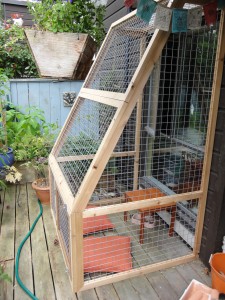Nicholas Read, a long-time VHS supporter, had a problem. Actually, two problems: Leo and Henry, his two very demanding (but adorable) ginger cats.
Both were accustomed to the outdoor life before Nick adopted them (Henry was semi-feral) and they have remained fiercely protective of their right to roam. But, as Nick lives on Vancouver’s west side he was worried about the dangers from urban wildlife.
After a lot of late-night worrying about when the “boys” would get home, Nick hit on the idea of building a pen on his deck, adjacent to his apartment window, that would allow Leo and Henry to jump out and in as they wished throughout the night. While various ready-made cat pens can be found on the Internet, Nick wanted something custom-made to ensure his cats could have safe, easy indoor/outdoor access, with an enclosure that was hard-wearing and aesthetically pleasing.
Fortunately, Nick discovered that one of his friends was a talented woodworker who enjoys challenges. Scott McLean, a college instructor, jumped at the opportunity to design and build a suitable enclosure. For Nick, it couldn’t come too soon.
“Leo and Henry have been going outside for years, so it’s impossible to keep them in all the time, he says. “But I worry about coyotes and birds. I worry about coyotes killing them, and them killing birds. So it seemed a good compromise to ask Scott to build an enclosure. This way they can still go out at night and be safe. And when I’m away and they have to be kept inside, they can still get fresh air.”
Scott describes his approach to the task: “When designing the pen I considered its function, but also how it would fit into Nick’s deck environment. I appreciated that the cats had their needs, but also was mindful of avoiding a situation where it overwhelmed his deck. In Nick’s case a slanted front was used to lessen the vertical space that was taken up by the pen, which added interest and gave it a less obstructive look, all without compromising the function for the cats. The design of Nick’s pen uses a cedar wooden frame with the metal mesh as the filler. I think the use of wood gives the enclosure a polished look and takes the industrial edge off. It also fits in well with the wooden deck, planters and a garden environment.”
Scott also took in a number of practical elements. First, the wood needed to be protected from the weather. Mitred joints were used in the construction so that the end grain of the wood was not exposed and there was less chance that the wood will soak in water and rot prematurely. The bolts and hardware are all weather resistant and caulking is used to prevent water from pooling and rotting out the wood.
Second, the enclosure had to be relatively easy to assemble and disassemble. Only two wrenches are needed to assemble the pen and it is constructed of several panels, each of which is not too heavy or awkward to move by oneself. The construction of the pen in several smaller panels also means that it can be stored without taking up too much space and can be moved to different locations without the need of a large truck.
Nick was thrilled with the result, but would the cats approve? Leo immediately jumped in to investigate and now enjoys his new outdoor rec-room. Henry took some coaxing (actually a gentle push) but has also given the enclosure the paws-up.
Scott enjoyed the project so much, he would welcome the opportunity to help others by making specially-built enclosures available to demanding cats on the Lower Mainland.
“The cat enclosures are fully custom,” he says. “Any shape or size is possible, which is a great advantage since we all have different spaces and needs. If a customer was looking to start small and then add on in the future, this desire could be incorporated into the original design. There are many choices out there in terms of metal mesh and wood. The selection of the materials would be made in consultation with the customer, but also in consideration to the environment in which the enclosure would live. Also, things like sustainably harvested wood can be used if this is important to the customer, as it was in Nick’s case.”
Cost of the enclosures is dependent on the size and the materials selected. Enclosures similar to Nick’s cost approximately $900 plus tax. Scott McLean can be contacted at scottdouglasmclean@gmail.com
Since this article was first drafted, other catio producers have come ‘out of the woodwork’ including Catioasis.

